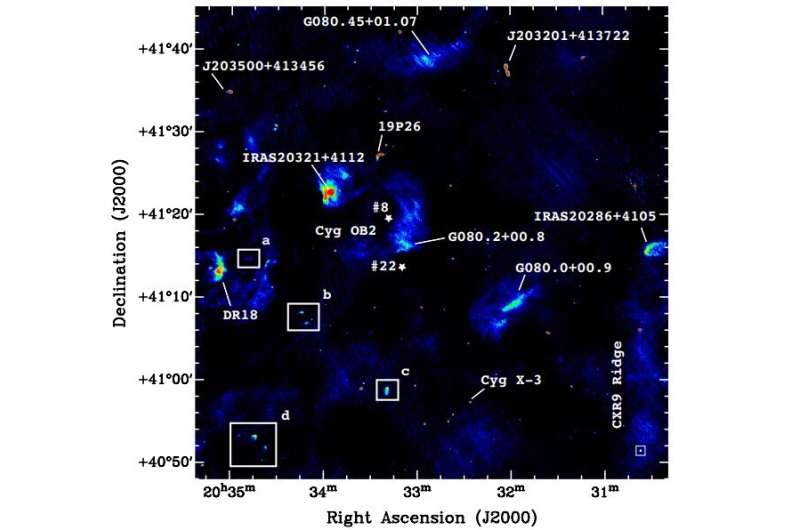April 29, 2019 report
Swan EGGs in the sky: Astronomers conduct radio observations of free-floating evaporating gas globules in Cygnus OB2

Using the Giant Metrewave Radio Telescope (GMRT), astronomers have carried out radio observations of the so-called free-floating evaporating gas globules or (frEGGs) in the Cygnus OB2 region. Results of this observational campaign, presented in a paper published April 17 on arXiv.org, provide more details about the properties of these peculiar objects.
Externally illuminated photo-evaporating protoplanetary disks, or proplyds for short, are ionized circumstellar disks around young low-mass stars the size of our solar system. Their ionized material is known to form a thermal disk wind with a cometary structure. Most proplyds identified so far have been spotted in the Orion nebula, the closest region of massive star formation to our planet.
FrEGGs are proplyd-like objects isolated from their parental molecular clouds. The are also externally ionized and present extended cometary morpologies. However, they are at earlier evolutionary stages than proplyds, with protostars still undergoing strong accretion and with larger molecular masses when compared to ionized protoplanetary disks. Moreover, frEGGs are are about 10 times larger than proplyds, which suggests that they can contain not just one but even several young protostars.
For astronomers and astrophysicists, frEGGs are perceived as possible accelerators of cosmic rays, and perhaps even putative gamma-ray sources. Therefore, these objects could serve as new laboratories for the investigation of particle acceleration processes in slow flows, and in addition as counterparts of unidentified gamma-ray sources.
FrEGGs were first spotted in the Cygnus OB2 association—one of the most massive stellar associations in our Milky Way galaxy, located some 4,700 light years away from the Earth. In a new study, a group of astronomers led by Natacha Isequilla of the National University of La Plata in Argentina, has focused on radio observations of eight such objects in this association, designated WDDGGHK 2-4 and WDDGGHK 6-10. The observations, conducted with GMRT at frequencies of 325 and 610 MHz, allowed them to learn more about physical properties of these proplyd-like objects.
"We present 325 and 610 MHz GMRT continuum observations toward the Cygnus OB2 region and report on the characteristics of the population of externally ionized proplyd-like objects also known as frEGGs," the researchers wrote in the paper.
Based on GMRT observations, the scientists estimated the studied objects' electronic densities, ionized mass, optical depth and the amount of photons needed to be ionized. They also compared the properties, mainly the ionizing photon rate, with those of other massive stars in the neighborhood. All in all, this resulted in the conclusion that the stellar systems Cyg OB2 #9 and Cyg OB2 #22 are probably responsible for the ionization of the observed frEGGs.
"Using their geometry and the photoionization rate needed to produce their radio-continuum emission, we find that these sources are possibly ionized by a contribution of the stars Cyg OB2 #9 and Cyg OB2 #22," the paper reads.
Furthermore, the astronomers found that the main contribution to the continuum radio-emission in the studied frEGGs is thermal, while also regions with non-thermal emission could exist in these objects. In the case of one object, designated WDDGGHK 7 (dubbed the Tadpole because of its morphology) they assume that its emission is not of non-thermal origin.
More information: N.L. Isequilla et al. Radio observations of evaporating objects in the Cygnus OB2 region. arXiv:1904.08317 [astro-ph.SR]. arxiv.org/abs/1904.08317
© 2019 Science X Network




















